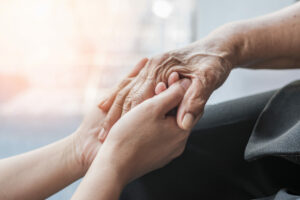In this post
Respiration is the chemical reaction that occurs in all living cells. It is the process involving the production of energy from the food we eat. A cell gets its energy by breaking down food molecules which then releases the stored chemical energy contained in the food.
Energy is an essential requirement for a number of life processes. For example:
- Movement
- Growth and repair
- The control of body temperature (only in mammals)
Because energy is an essential requirement for life, the cells of an organism require respiration pathways. Metabolic pathways are localised by cell membranes. Cell membranes create large surface areas and compartments which allow for high reaction rates to take place. Every cell has an outer cell membrane; however, many cells in living organisms also contain membrane-bound organelles. These include chloroplasts, mitochondria and a nucleus. The respiration pathways can occur both on the surfaces of the membrane but also in the inner compartments of some membranes.
The majority of consumed food ends up as glucose and so this is the main component that provides animal cells with energy. Remember, the chemical formula for glucose is C6H12O6.
In order to turn glucose into energy, firstly it needs to be combined with six molecules of oxygen (this is known as oxidising glucose – the process of oxidation refers to the loss of electrons). When a molecule of glucose is oxidised it creates six molecules of carbon dioxide (CO2), six molecules of water (H2O) and some energy. Using a simplified diagram, this is the process of cell respiration:

To break it down, the majority of the energy gained from oxidising glucose is made up of heat (mainly used to help a mammal regulate their body temperature) and approximately 38 ATPs (adenosine triphosphate). The heat from the energy is sometimes referred to as a by-product as the main source of energy for a cell is derived from ATP molecules.

A lot of mitochondria are present in cells that require a lot of energy, for example nerve cells and muscle cells. This is because the majority of the process of respiration takes place in the mitochondria part of a cell. There are two types of respiration, one requiring oxygen (aerobic respiration) and one that does not require any oxygen (anaerobic respiration) – more about the differences between these two processes in a later chapter.
Diffusion
When a cell requires to undergo the process of respiration, the concentration of glucose and oxygen will be lower inside the cell than in the surrounding blood; this results in the substances diffusing into the cell. Similarly, as the process of respiration causes a build-up of CO2 in the cell, the concentration of this will be higher in the cell than outside of the cell, causing it to diffuse out of the cell and into the surrounding blood.
ATP
ATP is a high-energy molecule found in every living cell. Energy is essential in being able to carry out all of the processes required for life. Through the breakdown of food molecules and cellular respiration, cells can release the stored energy contained in the food before transferring it into ATP.
ATP molecules contain an adenine base, a type of sugar known as ribose and three phosphate groups. It is useful to think of the phosphate groups as being the same ends of a magnet; they repel each other and the force created by this results in the last two bonds of the phosphate group containing a high amount of energy:

Many cells contain a substance known as ATPase. ATPase is an enzyme that acts to cut off the last phosphate bond, releasing the energy from ATP that the cell can then use. The molecule is then known as ADP (adenosine diphosphate) because only two phosphate groups are present instead of three. ADP is a low energy molecule. When ATP converts to ADP it is said to be ‘spent’.

A phosphate bond can be re-added to the ADP molecule turning it into ATP again. This requires free energy to be available in the cell. ATP can be recycled from ADP like this so that a constant stream of energy can be provided to the cell via ATP molecules.

The body uses ATP for a number of cellular and bodily processes; for example, DNA replication, active transport, synthetic pathways and muscle contraction.
The transformation of glucose into ATP (energy that the body can use) does not happen all at once. It is actually more complicated than how it has been explained in this chapter. It is a relatively slow cycle that takes place over three stages: glycolysis, the Krebs cycle and the electron transport chain. We will now go on to discuss these three stages.

Interested in a Biology GCSE?
We offer the Edexcel GCSE in Biology through our online campus.









